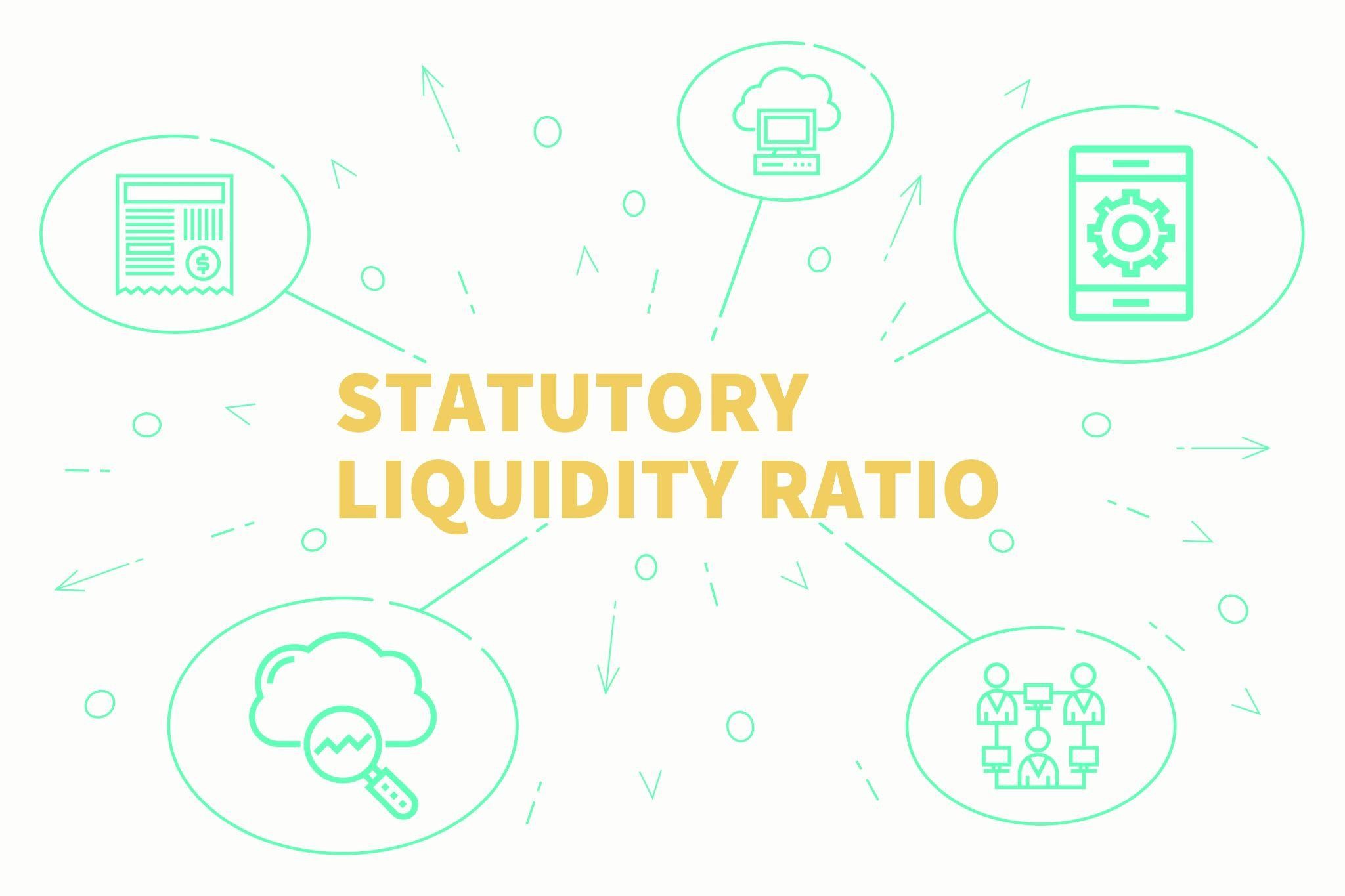Statutory Liquidity Ratio (SLR): Formula, Calculation and Working

What is Statutory Liquidity Ratio?
SLR (full form – Statutory Liquidity Ratio) is the minimum percentage of deposits that a scheduled commercial bank, a state or central cooperative bank, and other primary cooperative banks are required to maintain in the form of liquid assets, such as gold, cash, or other securities. The banks need not hold these deposits with the Reserve Bank of India (RBI). Instead they keep this reserve with themselves. The SLR rate is decided by the RBI, which uses it as one of the many monetary policy tools to manage inflation, credit growth, and flow of cash within the Indian financial ecosystem. In this blog, we will take a closer look at the SLR formula, its features, its impact on our economy, and more.
Trivia Corner
Did you know that as per RBI regulations, the maximum SLR rate cannot exceed 40%? The minimum can be 0%. As of 8th February, 2023, the statutory liquidity ratio rate is 18%.
How Does Statutory Liquidity Ratio (SLR) Work?
While the definition of SLR has been laid down in Section 24 (2A) of Banking Regulation Act (1949), RBI has the sole authority to periodically review and change it. The SLR limit has to be mandatorily maintained by banks on a daily basis. It is calculated as a percentage of the Net Demand and Time Liabilities (NDTL) (i.e. deposits) held by the bank.
Whenever the RBI increases the Statutory Liquidity Ratio limit, banks are required to increase their liquid asset reserve to maintain the SLR. This reduces the banks’ ability to lend money and inject credit into the economy. On the other hand, if the SLR limit is reduced, banks have additional funds to lend. This promotes credit growth in the economy and helps control inflation. It is also instrumental in determining a bank’s solvency in the medium to long term.
Features of Statutory Liquidity Ratio
- The SLR is the monetary reserve that banks are required to maintain in the form of liquid assets. It is a monetary policy tool that the RBI uses to regulate some of the major levers of our economy, such as cash flow, inflation, and credit lending.
- Banks reserve the SLR themselves and not with the RBI.
- Every commercial bank, primary co-operative banks in urban areas, local area banks, and State and Central co-operative banks have to maintain the stipulated SLR.
- Non-maintenance of the SLR incurs penalties for banks.
- The Statutory Liquidity Ratio limit is fixed by the RBI and reviewed periodically. The RBI can increase or decrease the limit based on its monetary policy objectives and the state of the economy.
Components of the Statutory Liquidity Ratio (SLR)
As discussed already, all RBI-regulated banks must reserve a portion of their deposits in the form of liquid assets. The following are the components that helps a bank meet its specified SLR limit:
| Component | Meaning |
| Liquid assets | Liquid assets of a bank are those securities that can be converted to cash instantly. Examples include Treasury Bills (T-Bills), sovereign bonds, cash reserves, gold, and other government-approved securities |
| Net Demand and Time Liabilities (NDTL) | The different types of deposits offered by banks fall under this category: • Demand deposits are those that have no lock-in period. Customers can withdraw such deposits whenever they want. Examples include savings accounts, current accounts, demand drafts, and overdue fixed deposits among others • Time deposits, on the other hand, are those that have a specific maturity date. Such deposits are held by the bank till they mature. Examples include fixed deposits, recurring deposits, and certificates of deposit among others. • Other liabilities of the bank would include money-market borrowings, deposits in other banks, etc. |
Also Read
How Is the Statutory Liquidity Ratio Calculated (SLR)?
In order to calculate the SLR percentage or ratio, you need to know the two components of SLR. The Statutory Liquidity Ratio formula is given below:
Statutory Liquidity Ratio Formula – How to Calculate SLR
SLR = {Liquid assets / (Net Demand + Time Liabilities)} x 100%
For instance, if a bank has ₹10 Lakh Crore in liquid assets and ₹300 Lakh Crore in NDTL, the SLR would be calculated as follows –
SLR= ₹10 Lakh Crore / ₹300 Lakh Crore x 100% = 3.33%
Statutory Liquidity Ratio Limit in 2023
As mentioned earlier, the RBI decides the SLR limit after periodic reviews. The Statutory Liquidity Ratio limit in 2023 is 18%. This means that banks should maintain 18% of their NDTL in the form of liquid assets. For example, if the NDTL of a bank is ₹100 Lakh Crore, it should maintain ₹18 Lakh Crore in liquid assets.
Types of Institutions that Must Maintain the Stipulated SLR Limit
The following institutions must maintain the mandated statutory liquidity ratio limit as per Section 24 (2A) of Banking Regulation Act 1949:
- All scheduled commercial banks
- Central and state co-operative banks
- Local Area Banks
- Primary (Urbank) Co-operative Banks
As per Section 18 of the Banking Regulation Act 1949, non-scheduled banks must also maintain the prescribed SLR limit.
Objectives of Statutory Liquidity Ratio (SLR)
The SLR is an important monetary policy tool available to the RBI to control the banking industry and control the cash flow. Here are some important SLR objectives:
- The SLR helps the RBI control credit flow and supply of money within the financial ecosystem.
- Through the SLR, the RBI also makes it mandatory for banks to invest in Government securities that form a part of their liquid assets. This becomes a source of revenue for the government to manage its own expenses and to fund its various initiatives.
- SLR is a tool to control inflation. By raising the SLR limit, the RBI can force banks to park more money in government securities and have less funds to lend. This increases the cost of borrowing and elevates price levels – a key lever to increase inflation. The opposite happens when the SLR limit is reduced.
- The SLR also ensures the solvency of banks. As banks are mandated to hold a percentage of their deposits in liquid assets, they can use the same to pay off their creditors in case of an economic emergency.
- In combination with the Cash Reserve Ratio (CRR), SLR helps prevent over-lending and credit expansion, which in turn can help keep debts at reasonable levels.
How Is the Correct SLR Level Ascertained?
As explained already, statutory liquidity ratio helps banks create a safety net to meet their obligations to depositors and other creditors. In the same vein, a bank’s risk capital is the safe buffer it must maintain to ensure that it is able to meet its obligations, while also having the legroom for absorbing losses.
So, a bank’s risk capital should be such that it is able to comply with the stipulated SLR limit and also function efficiently. This means that the SLR determines the bank’s risk capital and vice versa. So, to determine an SLR limit that is appropriate, the RBI considers the risk capital of banks. To simplify it further, a bank with a higher risk capital will be able to take on more liabilities to stay within the SLR limit and grow its lending business. Similarly, a bank with a lower risk capital will have a smaller scope of lending or over-leveraging its assets.
What Could Happen if SLR is Not Maintained?
Banks are required to maintain the specified SLR limit and report the same to the Reserve Bank of India regularly. In the case of non-maintenance of the specified SLR, the RBI levies a penalty on the bank, which negatively impacts their profitability.
The following is the current rate at which penalty is imposed on banks for SLR non-compliance:
| Default Type | Penalty |
| Default for the first time | 3% p.a. fine in addition to the interest rate that banks pay to RBI |
| Default on the next working day | 5% p.a. fine + the interest rate charged by RBI |
Impact of Statutory Liquidity Ratio on the Economy
- An increased SLR restricts a bank’s lending capacity. This restricts credit expansion and keeps leverage (i.e. use of debt to meet financial obligations to undertake projects) in check.
- The SLR also influences the base rate of lending, i.e., the minimum rate at which banks would offer loans. This promotes transparency in loan interest rates across different banks.
- The ratio helps maintain banks’ financial solvency, which makes the banking sector more stable.
- SLR helps the government to manage its debts by selling its securities to banks. It is also a source of revenue for the government.
What is a Cash Reserve Ratio (CRR)?
Besides the SLR, the Cash Reserve Ratio (CRR) is an important monetary policy tool that the RBI has at its disposal. The CRR is the minimum specified percentage of a bank’s Net Demand and Time Liabilities (NDTL) (i.e. deposits) that it has to maintain in the form of cash or cash equivalents. The bank has the option to either keep the cash reserves in its vaults or park it with the Reserve Bank of India (RBI).
The RBI decides the CRR rate and periodically reviews it based on its assessment of the economy.
Difference Between SLR and CRR
Though the SLR and the CRR have some similarities, they have major differences too. Let’s take a look at them in the table below:
| Statutory Liquidity Ratio (SLR) | Cash Reserve Ratio (CRR) |
| The SLR helps the RBI control the growth of credit in the country | The CRR helps RBI control the liquidity levels in the Indian financial system |
| In order to meet the SLR limit, a bank need not maintain its reserves with the RBI | Banks can maintain CRR with themselves or park their reserves with the RBI |
| The SLR can be maintained in the form of liquid assets, including cash, gold, or other government-approved securities | The CRR is maintained only in the form of cash or cash equivalents |
| Banks have an opportunity to earn interest from their reserves held to meet SLR because they invest in a variety of sovereign bonds and other liquid assets | A bank doesn’t earn any interest on the cash reserves it maintains with the RBI |
| The current SLR limit is 18%* | The current CRR rate is 4.5%* |
Final Word
The Statutory Liquidity Ratio (SLR) is an important monetary policy regulation that banks must comply with. It has a massive impact on the country’s inflation, credit growth, cash flow, bank solvency, and on how the government manages its debts. It is also important for whoever borrows money from banks or parks money in various types of deposits. That’s because SLR acts as a safety net for the depositor’s money.
As we are on the subject of money, how about we share a secret with you that could help you increase your own wealth? Are you aware that Navi offers index mutual funds that are a simple, low-cost, and transparent way to maximise your returns potential? And that’s not all. You could start your investment journey with as little as ₹10. To explore the various mutual fund schemes we offer, download the Navi App today.
FAQs
No, the SLR and the CLR are independent ratios. Banks have to maintain each ratio independently. So, if the SLR is 18% and CRR is 4%, banks should have a separate SLR reserve of 18% of their Net Deposit and Time Liabilities and another 4% for maintaining their CRR.
No, there is no specific percentage for buying Government securities to constitute the SLR reserve.
No, gold is not mandatory. However, banks often use gold as a part of their cash reserves.
Yes, the SLR can be increased or decreased by the RBI depending on the monetary policy the RBI wants to adopt.
To control inflation, RBI increases the SLR. This requires banks to maintain a higher amount of reserve which, in turn, restricts their lending capacity and reduces the availability of funds in the hands of the household.
The full form of SLR is Statutory Liquidity Ratio.
The purpose of SLR is to control the credit growth and flow of cash into the economy. It also creates a safety net for banks and its depositors because the banks are forced to hold a portion of their total reserves as liquid assets, which can be used to pay off its liabilities in the case of a financial crisis.
When SLR is high, it helps contain inflation because it limits a bank’s ability to expand credit or lending. This increases the cost of borrowing and other prices, thereby slowing economic growth but increasing stability.
Personal Loan in Your City

Customer’s Feedback
No comments found.10 Best Bank for Savings Account in India [Highest Interest Rate 2023]
Savings account is a type of financial instrument offered by several banks. It lets you safely depo... Read More »What is Issuer Identification Number (IIN)- Working and Importance
What is an Issuer Identification Number (IIN)? Banks and financial institutions assign a distinc... Read More »What is a Vostro Account – Meaning, Working and Difference
What is a Vostro Account? A Vostro account is a bank account held by a domestic bank on behalf o... Read More »What is a Solvency Certificate? – Format, Documents Required & How to Apply Online?
What is a Solvency Certificate? A solvency certificate is a legal document furnishing the detail... Read More »What is Merchant Banking – Services, Features, Functions and Example
What is Merchant Banking? Merchant banking is a set of select banking and financial services off... Read More »Automated Clearing House: Objectives, Types and Process
Automated Clearing House is an electronic fund transfer network that manages automatic and direct... Read More »How to Redeem Credit Card Reward Points ?
Credit Card Reward points are types of incentives that customers receive when they use a credit car... Read More »What is Electronic Clearing Service (ECS) in Banking and How does it Work?
What is Electronic Clearing Service (ECS)? Electronic Clearing Service (ECS) is a method of elec... Read More »What are Credit Card Validators and How to Use them?
What is a Credit Card Validator? A credit card validator is a tool that checks the validity of a... Read More »What is Cash Management and How Does it Work?
Managing available capital can make sure that a small business stays afloat. Cash management is an ... Read More »What are Prepaid Expenses? – Definition, Examples, and Journal Entry
Prepaid expenses represent payments made in advance for products or services expected to be incurre... Read More »Increase Credit Card Limit – Important Tips and How to Do It?
The credit card limit is the maximum amount of money you can spend using your credit card. Your cre... Read More »Top 10 Chit Fund Schemes in India in 2023
Chit funds are one of the most popular return-generating saving schemes in India. It is a financial... Read More »10 Best Gold ETFs in India to Invest in April 2023
Gold ETFs or Gold Exchange Traded Funds are passively managed funds that track the price of physica... Read More »10 Best Demat Accounts in India for Beginners in 2023
Creation of Demat accounts revolutionised the way trades were conducted at the stock exchanges. It... Read More »20 Best Index Funds to Invest in India in April 2023
What is an Index Fund? An index fund is a type of mutual fund or exchange-traded fund (ETF) that... Read More »Best Arbitrage Mutual Funds to Invest in India in April 2023
Arbitrage funds are hybrid mutual fund schemes that aim to make low-risk profits by buying and sell... Read More »10 Best SIP Plans in India to Invest in April 2023
What is SIP? SIP or Systematic Investment Plan is a method of investing a fixed amount in ... Read More »10 Best Corporate Bond Funds in India to Invest in April 2023
Corporate bond funds are debt funds that invest at least 80% of the investment corpus in companies ... Read More »10 Best Bank for Savings Account in India [Highest Interest Rate 2023]
Savings account is a type of financial instrument offered by several banks. It lets you safely depo... Read More »





















